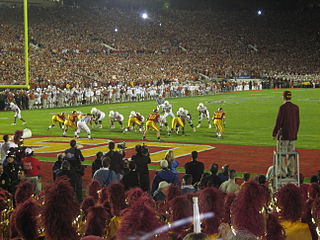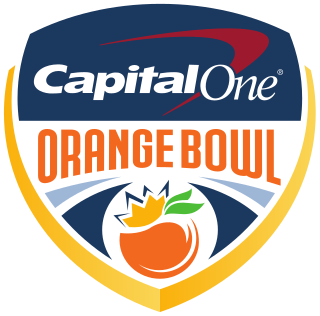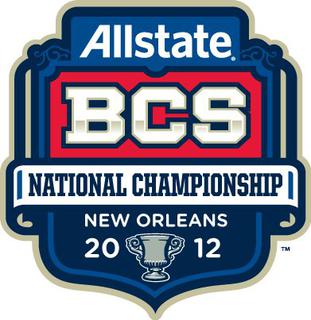
The Sugar Bowl is an annual American college football bowl game played in New Orleans, Louisiana. Played annually since January 1, 1935, it is tied with the Orange Bowl and Sun Bowl as the second-oldest bowl games in the country, surpassed only by the Rose Bowl Game.

The Peach Bowl is an annual college football bowl game played in Atlanta, Georgia, since December 1968. Since 1997, it has been sponsored by Chick-fil-A and is officially known as the Chick-fil-A Peach Bowl. From 2006 to 2013, it was officially referred to as simply the Chick-fil-A Bowl. The winner of the bowl game is awarded the George P. Crumbley Trophy, named after the game's founder George Crumbley.

The Bowl Championship Series (BCS) was a selection system that created four or five bowl game match-ups involving eight or ten of the top ranked teams in the NCAA Division I Football Bowl Subdivision (FBS) of American college football, including an opportunity for the top two teams to compete in the BCS National Championship Game. The system was in place for the 1998 through 2013 seasons and in 2014 was replaced by the College Football Playoff.
The NCAA Division II Football Championship is an American college football tournament played annually to determine a champion at the NCAA Division II level. It was first held in 1973, as a single-elimination tournament with eight teams. The tournament field has subsequently been expanded three times; in 1988 it became 16 teams, in 2004 it became 24 teams, and in 2016 it became 28 teams.

In North America, a bowl game, or simply bowl, is one of a number of postseason college football games that are primarily played by teams belonging to the NCAA's Division I Football Bowl Subdivision (FBS). For most of its history, the Division I Bowl Subdivision had avoided using a playoff tournament to determine an annual national champion, which was instead traditionally determined by a vote of sports writers and other non-players. In place of such a playoff, various cities across the United States developed their own regional festivals featuring postseason college football games. Prior to 2002, bowl game statistics were not included in players' career totals. Despite attempts to establish a permanent system to determine the FBS national champion on the field, various bowl games continue to be held because of the vested economic interests entrenched in them.

The BCS National Championship Game, or BCS National Championship, was a postseason college football bowl game, used to determine a national champion of the NCAA Division I Football Bowl Subdivision (FBS), first played in the 1998 college football season as one of four designated bowl games, and beginning in the 2006 season as a standalone event rotated among the host sites of the aforementioned bowls.
Mid-major is a term used in American college sports at the NCAA Division I level, particularly men's basketball, to refer to athletic conferences that are not among the ACC, AAC, Big East, Big 10, Big 12, Pac-12, and SEC, which are alternatively referred to as "high majors". The term "mid-major" was coined in 1977 by Jack Kvancz, the head coach of men's basketball team at Catholic University. NCAA neither acknowledges nor uses the terms "major" or "mid-major" to differentiate between Division I athletic conferences. Some schools and fans consider it offensive and derogatory, while others embrace the term.
The teams that participate in the National Collegiate Athletic Association's Division I Football Bowl Subdivision earn the right to compete in a series of post-season games called bowl games. As of 2023, there are 42 bowl games, and all are contractually obligated to offer bids to specific conferences, a situation known as a "tie-in". The "top" six bowl games in the nation select their teams as part of the College Football Playoff (CFP), which was put into place for a minimum of 12 years, beginning with the 2014 season. Prior to 2014, the top five games in the country were chosen under the system known as the Bowl Championship Series. The bowls outside of the CFP have individual contracts with the conferences to offer preferential bids to teams from those conferences. As long as teams are bowl eligible, they may be selected by these bowls to meet these contracts.
The Bowl Championship Series (BCS) was a selection system used between 1998 and 2013 that was designed, through polls and computer statistics, to determine a No. 1 and No. 2 ranked team in the NCAA Division I Football Bowl Subdivision (FBS). After the final polls, the two top teams were chosen to play in the BCS National Championship Game which determined the BCS national champion team, but not the champion team for independent voting systems. This format was intended to be "bowl-centered" rather than a traditional playoff system, since numerous FBS Conferences had expressed their unwillingness to participate in a play-off system. However, due to the unique and often esoteric nature of the BCS format, there had been controversy as to which two teams should play for the national championship and which teams should play in the four other BCS bowl games. In this selection process, the BCS was often criticized for conference favoritism, its inequality of access for teams in non-Automatic Qualifying (non-AQ) Conferences, and perceived monopolistic, "profit-centered" motives. In terms of this last concern, Congress explored the possibility on more than one occasion of holding hearings to determine the legality of the BCS under the terms of the Sherman Anti-Trust Act, and the United States Justice Department also periodically announced interest in investigating the BCS for similar reasons.

The NCAA Division I Football Bowl Subdivision (FBS), formerly known as Division I-A, is the highest level of college football in the United States. The FBS consists of the largest schools in the National Collegiate Athletic Association (NCAA). As of the 2023 season, there are 10 conferences and 133 schools in FBS.
The college football playoff debate was a very hot topic of discussion, concerning college football in the United States, among fans, journalists, conference representatives, government officials, university administrators, coaches and players concerning whether or not the current postseason format of the Football Bowl Subdivision should be changed or modified. Playoff proponents had argued that a bracket-style playoff championship should replace the Bowl Championship Series, while others advocated for a Plus-one format, which would have created a single national championship game with participants selected after the conclusion of the traditional bowl season. This debate has been going since at least 1971.

The Orange Bowl is an annual American college football bowl game that has been played annually in the Miami metropolitan area since January 1, 1935. Along with the Sugar Bowl and the Sun Bowl, it is one of the oldest bowl games in the country behind only the Rose Bowl, which was first played in 1902 and has been played annually since 1916. The Orange Bowl was originally held in the city of Miami at Miami Field before moving to the Miami Orange Bowl stadium in 1938. In 1996, it moved to its current location at Hard Rock Stadium in Miami Gardens, the home football field for both the University of Miami and Miami Dolphins. Since December 2014, the game has been sponsored by Capital One and officially known as the Capital One Orange Bowl. Previous sponsors include Discover Financial and Federal Express/FedEx (1989–2010).

The 2012 Allstate BCS National Championship Game was a postseason college football bowl game between the Alabama Crimson Tide and the LSU Tigers, and determined the national champion of the 2011 NCAA Division I FBS football season on Monday, January 9, 2012, at the Mercedes-Benz Superdome in New Orleans, Louisiana. The game was part of the 2011–2012 Bowl Championship Series and a rematch of regular season foes. Alabama beat LSU 21–0 to win their 14th national championship, marking the first shutout in a national championship game since the 1992 Orange Bowl and the first ever shutout in a BCS bowl game. The game had the third-lowest TV rating, 14.01, in the 14-year history of the BCS National Championship game.

The 2012–13 NCAA football bowl games were a series of college football bowl games. They concluded the 2012 NCAA Division I FBS football season, and included 35 team-competitive games and four all-star games. The games began on Saturday December 15, 2012 and, aside from the all-star games, concluded with the 2013 BCS National Championship Game in Miami Gardens, Florida that was played on January 7, 2013.

The College Football Playoff (CFP) is an annual postseason knockout invitational tournament to determine a national champion for the National Collegiate Athletic Association (NCAA) Division I Football Bowl Subdivision (FBS), the highest level of college football competition in the United States. Four teams play in two semifinal games, and the winner of each semifinal advances to the College Football Playoff National Championship game.
The 2013–14 NCAA football bowl games were a series of college football bowl games. They concluded the 2013 NCAA Division I FBS football season, and included 35 team-competitive games and three all-star games. The games began on Saturday December 21, 2013 and, aside from the all-star games, ended with the 2014 BCS National Championship at the Rose Bowl in Pasadena that was played on January 6, 2014.
The 2015–16 NCAA football bowl games were a series of college football bowl games. They completed the 2015 NCAA Division I FBS football season. The games began on December 19, 2015 and, aside from the all-star games, ended with the 2016 College Football Playoff National Championship which was played on January 11, 2016.

The New Year's Six, sometimes abbreviated as NY6, is an unofficial but commonly used term used to describe the following NCAA Division I Football Bowl Subdivision (FBS) bowl games: the Rose Bowl, Sugar Bowl, Orange Bowl, Cotton Bowl, Peach Bowl, and Fiesta Bowl. These games are played annually on or around New Year's Day and represent six of the ten oldest bowl games played at the FBS level.









